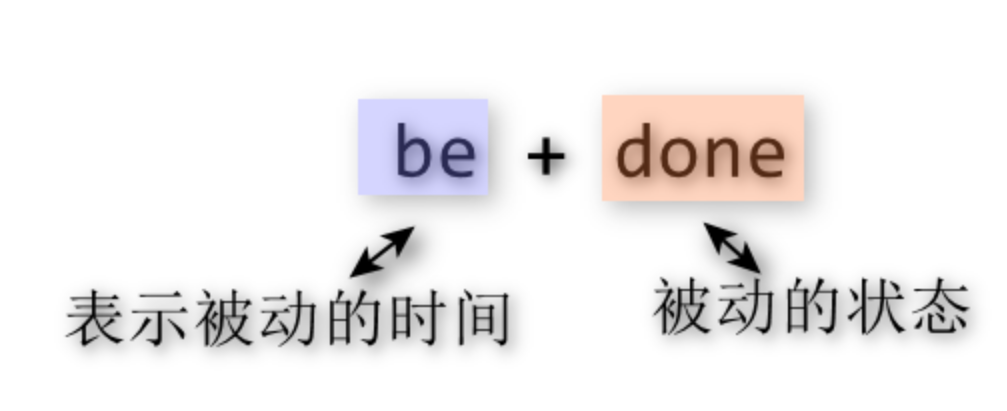英语语法_语态
1. 语态
分类: ①主动语态,②被动语态
主动或被动由动词本身定义有关,即 分为及物动词和非及物动词(非及物动词物被动)
1、被动语态
组成部分:

⚠️ be动词的存在为了表示 时间 ,而 done是为了表现语态
适用条件: 及物动词 / 不及物动词 + 介词
形式: be + Ved ,Ved表示谓语动词过去式,be表示 这里是be动词(具体什么形态根据情况)
eg: The dog has ate this cate. (主动+完成)
eg: This cate has been ate by the dog. (完成+被动)
eg: Classrooms are cleaned every day. (被动)
eg: I sleep on her shoulder. (主动)
eg:Her shoulder **is slept on ** by me. (被动)
2、被动语态和时态相结合
eg: 一座新的大楼去年建造。
A new building was built last year. (被动+过去)
eg: 他现在正在被打。 He is being beaten. (被动+进行)
eg: 他现在已经被打了。 He has been beaten. (被动+现在完成)
⚠️注意 完成被动的变化
复制完成时态: has + done
被动时态: be + Ved
完成被动时态: has been + Ved , be动词的完成时是 been
即 has been beaten
即将 两者结合起来
⭐想要表达的意思中 既有时间要求也有 状态要求, 就需要表现出这两个
①be动词表现时间
②实义动词表现状态
3、与情态动词结合
飞机能够被听见。
Planes can be heard.
Planes could be heard.
Planes may be heard.
1.1. 情态
情态是什么?用什么作用?
- 表示人的情绪和态度
形式: 情态动词 + 动词原型
特点: 无人称变化要求,时态变化有限
| 现在时 | 过去时 |
|---|---|
| must | 无 |
| can | could |
| will | would |
| shall(和I/we连用,表将来) | should |
| may | might |
👁️🗨️ Could,would,should,might不仅可以表示 过去,还能表示 委婉态度
eg: Could you help me.
1、must
- 情态: 强制语气,命令,表示 “必须”
eg: We must finish the work within a week.
2、can/could
- 情态: “能够,可以”
eg: The govermetn can solve the problem of water pollution. 【现在】
eg: Tony could walk when he was only one year old. 【过去】
3、will/would
- 情态: “愿意,将要”
eg: Wil you marry me.
eg: I would travel in the future, he said Last year.
4、may/might
- 情态: “可以,可能”
- eg: May i help you .
5、shall/should
- 情态: “应该”
eg: Students should work hard to pass the exams.
eg: Those sick people should seek help from doctors.
🌿简述非谓语动词
doing / to do 可作为非谓语动词充当 名词 (主语,宾语)
eg: Laughing probably has great influence on health. (做主语)
eg: It probably has great influence on health to laugh. (做宾语)
⚠️有的动词可接 doing形式名词,有的可接 to do 形式的名词
eg: We enjoy reading books in the library.
eg: The member of the board decide to vote against the new plan.
主要的差别在于 to + 不定式
enjoy reading book 说明的是一个事实,是确定的
deicde to vote 是一个想法,不知道是否确定
上述是 简单句的基本组成和基本变化
补充成分
1.2. 核心补充
1、什么内容将补充?
限定词,形容词副词,介词短语
2、常用的介词短语&连词
| 作用 | 举例 |
|---|---|
| 坐标/方位 | in, on, at / from to with /without, within between,among |
| 时间/方向 | before, after / since ,until ,during / into , onto |
| 归属/原因 | of ,by, for |
| 方式 | across ,through ,against |
| 举例/估计 | about / like ,as |
其中
by(通过...方式,方法 / 被... / 在..,旁)
for (为了... / 持续...时间)
3、非谓语动词
- doing (主动)
- done (被动)
- to do (目的)
eg: Passing planes can be heard night and day.
非谓语动词的修饰作用
可做成分: ①名词,②形容词(定语),③副词(状语)
eg: He bought a used car. (他买了一个被使用过的车) 【做形容词修饰名词】
eg: The teacher came into the classroom,followed by five students. (这个老师进入教室,跟着五个学生) 【做状语修饰句子】
⚠️理解:
1)、首先,一句话只能有一个实义的谓语动词,其他动词都是非谓语形式
2)、只需要按照规则(和被修饰成分的关系)和意思,确定是 主动(doing)还是被动(done)还是 目的(to do)填写即可
第一句话: 动词有 “买” 和 “使用”, 表实义的谓语动词是“买”,非谓语动词是 “使用”第二句话: 动词有 “进入” 和 “跟着”, 表实义的谓语动词
是“进入”,非谓语动词是 “跟着”
4、同位语&插入语
来源: 博客园
作者: 茶哩哩
文章: 转载请注明原文链接:https://www.cnblogs.com/martin-1/p/14851395.html



【推荐】国内首个AI IDE,深度理解中文开发场景,立即下载体验Trae
【推荐】编程新体验,更懂你的AI,立即体验豆包MarsCode编程助手
【推荐】抖音旗下AI助手豆包,你的智能百科全书,全免费不限次数
【推荐】轻量又高性能的 SSH 工具 IShell:AI 加持,快人一步
· go语言实现终端里的倒计时
· 如何编写易于单元测试的代码
· 10年+ .NET Coder 心语,封装的思维:从隐藏、稳定开始理解其本质意义
· .NET Core 中如何实现缓存的预热?
· 从 HTTP 原因短语缺失研究 HTTP/2 和 HTTP/3 的设计差异
· 分享一个免费、快速、无限量使用的满血 DeepSeek R1 模型,支持深度思考和联网搜索!
· 使用C#创建一个MCP客户端
· 基于 Docker 搭建 FRP 内网穿透开源项目(很简单哒)
· ollama系列1:轻松3步本地部署deepseek,普通电脑可用
· 按钮权限的设计及实现